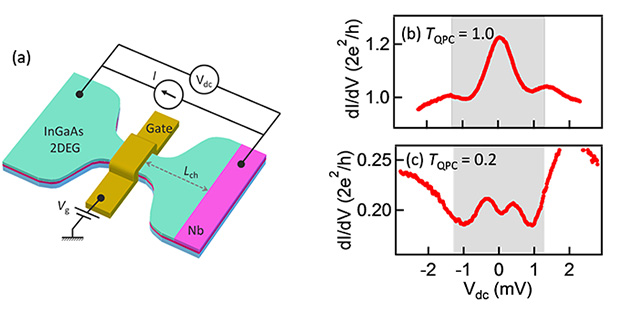Andreev Reflection and Bound State Formation in a Ballistic Two-dimensional Electron Gas Probed by a Quantum Point Contact
The superconducting proximity effect in superconductor-semiconductor hybrid structures has gained increased interest for studying exotic quantum phases [1] and developing novel electronic devices [2]. In such hybrid structures, charge transport near the interface is governed by Bogoliubov quasiparticles generated by Andreev reflections. Better control and sensitive detection of electronic properties of the quasiparticle are among the major challenges in the studies of the proximity effect.
We study transport properties of Bogoliubov quasiparticles in a high-mobility In0.75Ga0.25As two-dimensional electron gas (2DEG) coupled to a superconducting Nb electrode [3]. By using a quantum point contact (QPC) formed in the vicinity of the InGaAs/Nb interface as a single-mode probe with a tunable transmission [Fig. 1 (a)], we can study the effects of the boundary condition on the quasiparticle transport in the ballistic regime. Figure 1 (b) shows a differential conductance spectrum of a fully open QPC. The QPC shows a single-channel conductance greater than the conductance quantum 2e2/h at zero bias, which indicates the presence of Andreev-reflected quasiparticles returning back through the QPC. When the QPC transmission TQPC is reduced to the tunneling regime, the differential conductance spectrum probes the single-particle density of states in the proximity area. Measured conductance spectra exhibit a double peak within the superconducting gap of Nb [Fig. 1 (c)], demonstrating the formation of Andreev bound states in the 2DEG. Both of these results, obtained in the open and closed geometries, underpin the coherent nature of quasiparticles, i.e., phase-coherent Andreev reflection at the InGaAs/Nb interface and coherent propagation in the ballistic 2DEG.
- [1] V. Mourik et al., Science 336, 1003 (2012).
- [2] T. W. Larsen et al., Phys. Rev. Lett. 115, 127001 (2015).
- [3] H. Irie et al., Phys. Rev. B 94, 155305 (2016).

|
| Fig. 1. (a) Superconductor/semiconductor hybrid device studied. The distance between QPC and Nb contact Lch is 220 nm. (b,c) Differential conductance spectra measured in (b) the open-channel regime and (c) the tunneling regime. The grey areas represent the superconducting gap energy of Nb (1.3 meV). |